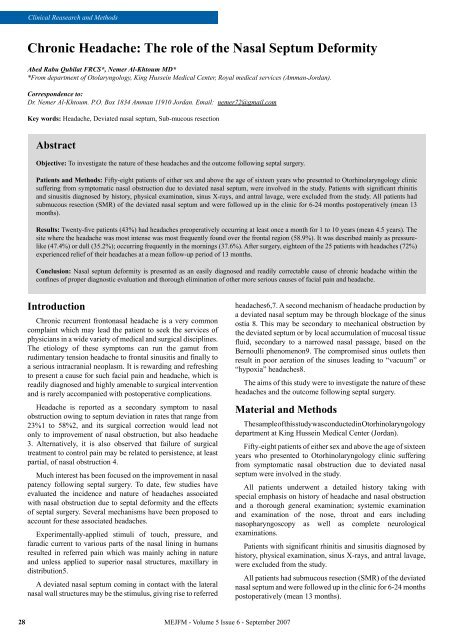Contents - Middle East Journal of Family Medicine
Contents - Middle East Journal of Family Medicine
Contents - Middle East Journal of Family Medicine
- No tags were found...
You also want an ePaper? Increase the reach of your titles
YUMPU automatically turns print PDFs into web optimized ePapers that Google loves.
Clinical Reasearch and Methods<br />
Chronic Headache: The role <strong>of</strong> the Nasal Septum Deformity<br />
Abed Rabu Qubilat FRCS*, Nemer Al-Khtoum MD*<br />
*From department <strong>of</strong> Otolaryngology, King Hussein Medical Center, Royal medical services (Amman-Jordan).<br />
Correspondence to:<br />
Dr. Nemer Al-Khtoum. P.O. Box 1834 Amman 11910 Jordan. Email: nemer72@gmail.com<br />
Key words: Headache, Deviated nasal septum, Sub-mucous resection<br />
Abstract<br />
Objective: To investigate the nature <strong>of</strong> these headaches and the outcome following septal surgery.<br />
Patients and Methods: Fifty-eight patients <strong>of</strong> either sex and above the age <strong>of</strong> sixteen years who presented to Otorhinolaryngology clinic<br />
suffering from symptomatic nasal obstruction due to deviated nasal septum, were involved in the study. Patients with significant rhinitis<br />
and sinusitis diagnosed by history, physical examination, sinus X-rays, and antral lavage, were excluded from the study. All patients had<br />
submucous resection (SMR) <strong>of</strong> the deviated nasal septum and were followed up in the clinic for 6-24 months postoperatively (mean 13<br />
months).<br />
Results: Twenty-five patients (43%) had headaches preoperatively occurring at least once a month for 1 to 10 years (mean 4.5 years). The<br />
site where the headache was most intense was most frequently found over the frontal region (58.9%). It was described mainly as pressurelike<br />
(47.4%) or dull (35.2%); occurring frequently in the mornings (37.6%). After surgery, eighteen <strong>of</strong> the 25 patients with headaches (72%)<br />
experienced relief <strong>of</strong> their headaches at a mean follow-up period <strong>of</strong> 13 months.<br />
Conclusion: Nasal septum deformity is presented as an easily diagnosed and readily correctable cause <strong>of</strong> chronic headache within the<br />
confines <strong>of</strong> proper diagnostic evaluation and thorough elimination <strong>of</strong> other more serious causes <strong>of</strong> facial pain and headache.<br />
Introduction<br />
Chronic recurrent frontonasal headache is a very common<br />
complaint which may lead the patient to seek the services <strong>of</strong><br />
physicians in a wide variety <strong>of</strong> medical and surgical disciplines.<br />
The etiology <strong>of</strong> these symptoms can run the gamut from<br />
rudimentary tension headache to frontal sinusitis and finally to<br />
a serious intracranial neoplasm. It is rewarding and refreshing<br />
to present a cause for such facial pain and headache, which is<br />
readily diagnosed and highly amenable to surgical intervention<br />
and is rarely accompanied with postoperative complications.<br />
Headache is reported as a secondary symptom to nasal<br />
obstruction owing to septum deviation in rates that range from<br />
23%1 to 58%2, and its surgical correction would lead not<br />
only to improvement <strong>of</strong> nasal obstruction, but also headache<br />
3. Alternatively, it is also observed that failure <strong>of</strong> surgical<br />
treatment to control pain may be related to persistence, at least<br />
partial, <strong>of</strong> nasal obstruction 4.<br />
Much interest has been focused on the improvement in nasal<br />
patency following septal surgery. To date, few studies have<br />
evaluated the incidence and nature <strong>of</strong> headaches associated<br />
with nasal obstruction due to septal deformity and the effects<br />
<strong>of</strong> septal surgery. Several mechanisms have been proposed to<br />
account for these associated headaches.<br />
Experimentally-applied stimuli <strong>of</strong> touch, pressure, and<br />
faradic current to various parts <strong>of</strong> the nasal lining in humans<br />
resulted in referred pain which was mainly aching in nature<br />
and unless applied to superior nasal structures, maxillary in<br />
distribution5.<br />
A deviated nasal septum coming in contact with the lateral<br />
nasal wall structures may be the stimulus, giving rise to referred<br />
headaches6,7. A second mechanism <strong>of</strong> headache production by<br />
a deviated nasal septum may be through blockage <strong>of</strong> the sinus<br />
ostia 8. This may be secondary to mechanical obstruction by<br />
the deviated septum or by local accumulation <strong>of</strong> mucosal tissue<br />
fluid, secondary to a narrowed nasal passage, based on the<br />
Bernoulli phenomenon9. The compromised sinus outlets then<br />
result in poor aeration <strong>of</strong> the sinuses leading to “vacuum” or<br />
“hypoxia” headaches8.<br />
The aims <strong>of</strong> this study were to investigate the nature <strong>of</strong> these<br />
headaches and the outcome following septal surgery.<br />
Material and Methods<br />
The sample <strong>of</strong> this study was conducted in Otorhinolaryngology<br />
department at King Hussein Medical Center (Jordan).<br />
Fifty-eight patients <strong>of</strong> either sex and above the age <strong>of</strong> sixteen<br />
years who presented to Otorhinolaryngology clinic suffering<br />
from symptomatic nasal obstruction due to deviated nasal<br />
septum were involved in the study.<br />
All patients underwent a detailed history taking with<br />
special emphasis on history <strong>of</strong> headache and nasal obstruction<br />
and a thorough general examination; systemic examination<br />
and examination <strong>of</strong> the nose, throat and ears including<br />
nasopharyngoscopy as well as complete neurological<br />
examinations.<br />
Patients with significant rhinitis and sinusitis diagnosed by<br />
history, physical examination, sinus X-rays, and antral lavage,<br />
were excluded from the study.<br />
All patients had submucous resection (SMR) <strong>of</strong> the deviated<br />
nasal septum and were followed up in the clinic for 6-24 months<br />
postoperatively (mean 13 months).<br />
28<br />
MEJFM - Volume 5 Issue 6 - September 2007
















